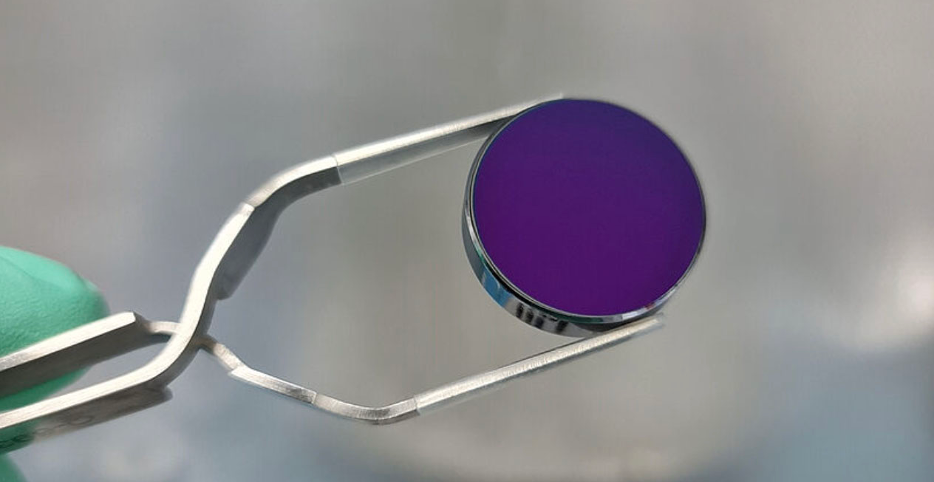A one-inch-diameter silicon substrate coated with a conventionally deposited interference coating.| Image Credit: © Valentin Wittwer – Institut de Physique, Université de Neuchâtel, Switzerland.

In a leading-edge achievement, researchers from Thorlabs Crystalline Solutions in Santa Barbara, the Faculty of Physics at the University of Vienna, and the National Institute of Standards and Technology in Gaithersburg have unveiled mid-infrared (MIR) supermirrors with finesse exceeding 400,000. The results of their study, titled "Mid-infrared supermirrors with finesse exceeding 400,000," have been published in the journal Nature Communications on December 6, 2023.
A one-inch-diameter silicon substrate coated with a conventionally deposited interference coating.| Image Credit: © Valentin Wittwer – Institut de Physique, Université de Neuchâtel, Switzerland.

A mid-infrared mirror with finesse exceeding 400,000 signifies a significant advancement in precision and sensitivity for infrared spectroscopy and trace gas sensing. This high finesse indicates the mirror's ability to minimize optical losses, enhancing signal-to-noise ratios and ensuring accurate detection of faint infrared signals. The breakthrough holds significant implications for improving instrumentation and detection in a variety of scientific and industrial applications.
For years, optical cavities incorporating low-loss mirrors have been crucial for trace gas sensing and precision spectroscopy. While advancements in visible and near-infrared (NIR) spectral regions have achieved finesse values surpassing 1 million, similar progress in the mid-infrared has been lacking. However, the recent research presents a significant breakthrough, demonstrating high-performance MIR mirrors with substrate-transferred single-crystal interference coatings.
The study, authored by Gar-Wing Truong, Lukas W. Perner, D. Michelle Bailey, and their colleagues, showcases these MIR mirrors capable of achieving cavity finesse values from 200,000 to an unprecedented 400,000 near the 4.5 µm spectral region, with optical losses below 5 parts per million (ppm).
In a first-of-its-kind proof-of-concept demonstration, the team achieved the lowest noise-equivalent absorption in a linear cavity ring-down spectrometer, normalized by cavity length. This breakthrough is poised to unlock a multitude of MIR applications, ranging from atmospheric transport and environmental sciences to the detection of fugitive emissions, process gas monitoring, breath-gas analysis, and the verification of biogenic fuels and plastics.
The researchers utilized two coating methods to realize these ultrahigh-finesse MIR mirrors. The first method extended the recently-reported "all-crystalline" architecture, producing a transmission-loss-dominated cavity finesse of 231,000 at 4.5 µm. The second "hybrid" approach yielded even higher finesse, exceeding 400,000. This new paradigm combines two different coating processes—an amorphous sub-stack deposition followed by bonding a crystalline multilayer on top.
These revolutionary MIR mirrors, with their simultaneous achievement of the highest finesse and lowest excess losses in this spectral region, hold promise for advancing sensing technologies.
The finesse and cavity transmission improvements enabled by these mirrors are expected to result in record-low levels of noise-equivalent absorption, as demonstrated by the successful trace gas detection in ultra-high purity nitrogen.
The researchers anticipate that this breakthrough will have far-reaching implications, opening avenues for unprecedented sensitivity and accuracy in a variety of scientific and industrial applications, ultimately pushing the boundaries of what is achievable in mid-infrared sensing technologies.
This article was written with the help of artificial intelligence and has been edited to ensure accuracy and clarity. You can read more about our policy for using AI here.
(1) Truong, G. W.; Perner, L.W.; Bailey, D. M. et al. Mid-infrared supermirrors with finesse exceeding 400,000. Nat. Commun. 2023, 14, 7846. https://doi.org/10.1038/s41467-023-43367-z
Rapid, Portable Mid-Infrared Spectroscopy Identifies Aflatoxins in Peanuts
March 10th 2025Researchers have developed a portable mid-infrared (IR) spectroscopic method combined with chemometric analysis to rapidly and non-destructively detect aflatoxin contamination in Aspergillus-infected peanuts. This approach offers a field-deployable alternative to traditional wet chemistry methods, with high sensitivity and specificity in identifying toxic metabolites such as aflatoxins.
Transforming Connectivity with a Comprehensive Review of IoT Sensors
March 3rd 2025A recent review by researchers at Nagpur University and Seth Kesarimal Porwal College explores the ever advancing landscape of the Internet of Things (IoT) and its essential components—sensors and actuators. The review paper classifies various IoT sensors and examines their role in integrating the physical and digital worlds to enable smarter devices and enhanced automation.